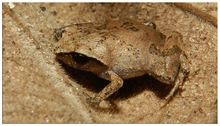Euparkerella
Euparkerella is a genus of craugastorid frogs. The common name coined for them is Guanabara frogs. They are endemic to Atlantic coastal forests in the southeastern Brazilian states Espírito Santo and Rio de Janeiro.[2] The name Euparkerella honours H. W. Parker, a herpetologist who named the type species, with the Greek prefix eu meaning true and suffix ella, a diminutive form.[3]
| Euparkerella | |
|---|---|
 | |
| Euparkerella brasiliensis | |
| Scientific classification | |
| Kingdom: | Animalia |
| Phylum: | Chordata |
| Class: | Amphibia |
| Order: | Anura |
| Family: | Craugastoridae |
| Subfamily: | Holoadeninae |
| Genus: | Euparkerella Griffiths, 1959[1] |
| Type species | |
| Sminthillus brasiliensis Parker, 1926 | |
| Diversity | |
| See text | |
Taxonomy
The phylogenetic position of Euparkerella is uncertain as they have not been included in any molecular phylogeny. On the basis of their morphological similarity to Holoaden, they are provisionally placed in subfamily Holoadeninae.[2][3] The AmphibiaWeb keeps Holoadeninae, and consequently Euparkerella, in Strabomantidae,[4] a family no longer recognized by the Amphibian Species of the World.[5]
Euparkerella species are traditionally distinguished using morphological traits. However, these species do not align well with genetically distinct units, with the latter suggesting higher diversity than the former, especially within Euparkerella brasiliensis and Euparkerella cochranae. It remains unresolved whether the genetically distinct units qualify as different species.[6]
Description
Euparkerella are small frogs, growing to 22 mm (0.87 in) snout–vent length at most. The digits are extremely reduced, compared to those of their larger relatives.[6] Head is narrower than the body. Differentiated tympanic membrane and tympanic annulus are absent. Dorsum is finely granular. Venter is areolate.[3]
Species
The following species are recognized in the genus Euparkerella:[2][4]
- Euparkerella brasiliensis (Parker, 1926)
- Euparkerella cochranae Izecksohn, 1988
- Euparkerella cryptica Hepp, Carvalho-e-Silva, Carvalho-e-Silva, and Folly, 2015
- Euparkerella robusta Izecksohn, 1988
- Euparkerella tridactyla Izecksohn, 1988
References
- Griffiths, I. (1959). "The phylogeny of Sminthillus limbatus and the status of the Brachycephalidae (Amphibia: Salientia)". Proceedings of the Zoological Society of London. 132 (3): 457–487. doi:10.1111/j.1469-7998.1959.tb05531.x.
- Frost, Darrel R. (2015). "Euparkerella Griffiths, 1959". Amphibian Species of the World: an Online Reference. Version 6.0. American Museum of Natural History. Retrieved 10 June 2015.
- Hedges, S. B.; Duellman, W. E. & Heinicke, M. P (2008). "New World direct-developing frogs (Anura: Terrarana): Molecular phylogeny, classification, biogeography, and conservation" (PDF). Zootaxa. 1737: 1–182.
- "Strabomantidae". AmphibiaWeb: Information on amphibian biology and conservation. [web application]. Berkeley, California: AmphibiaWeb. 2015. Retrieved 10 June 2015.
- Frost, Darrel R. (2015). "Craugastoridae Hedges, Duellman, and Heinicke, 2008". Amphibian Species of the World: an Online Reference. Version 6.0. American Museum of Natural History. Retrieved 10 June 2015.
- Fusinatto, L. A.; Alexandrino, J. £O.; Haddad, C. ©L. F. B.; Brunes, T. O.; Rocha, C. F. D.; Sequeira, F. (2013). "Cryptic Genetic Diversity is Paramount in Small-Bodied Amphibians of the Genus Euparkerella (Anura: Craugastoridae) Endemic to the Brazilian Atlantic Forest". PLoS ONE. 8 (11): e79504. doi:10.1371/journal.pone.0079504. PMC 3815154. PMID 24223956.